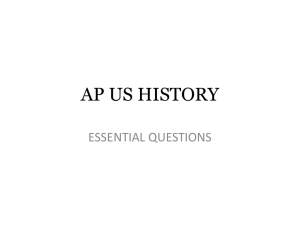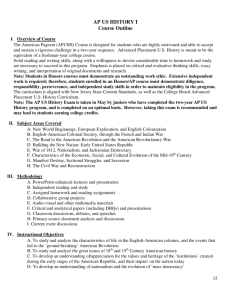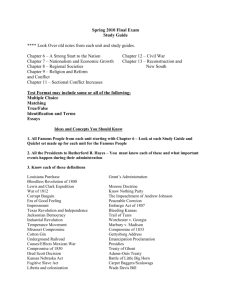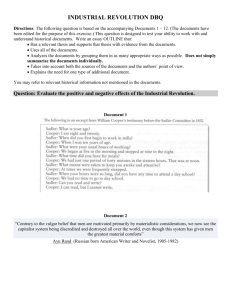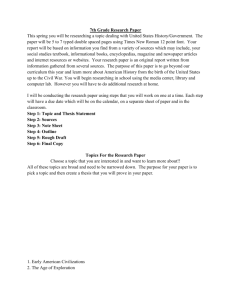US History I Course Outline: Revolution to WWI
advertisement
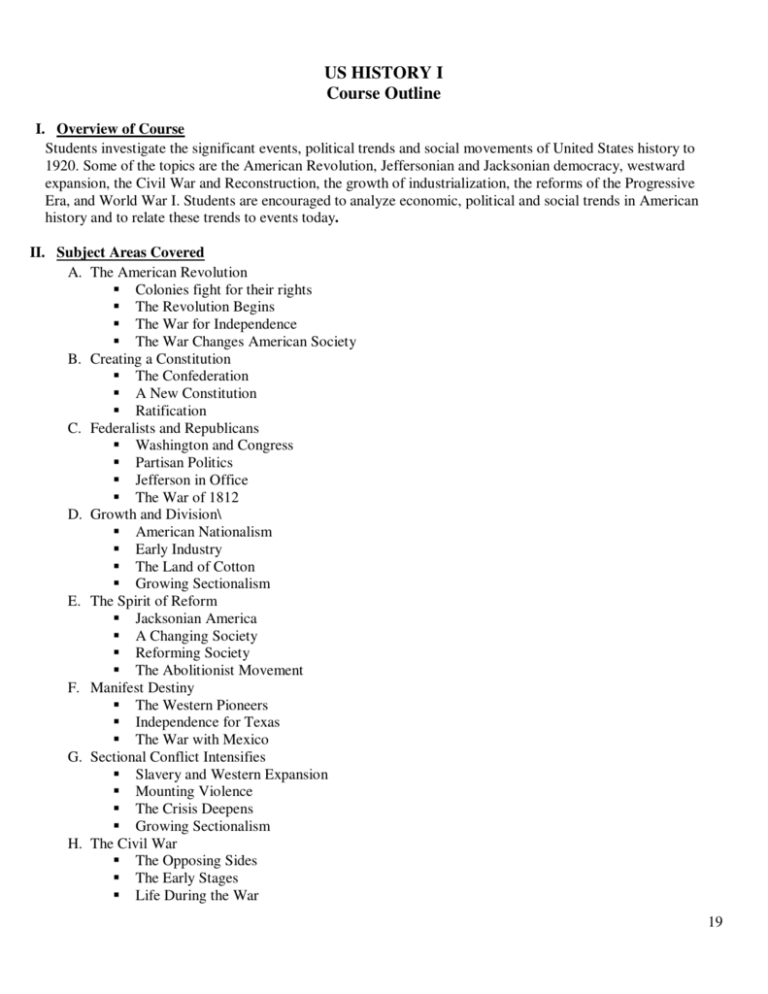
US HISTORY I Course Outline I. Overview of Course Students investigate the significant events, political trends and social movements of United States history to 1920. Some of the topics are the American Revolution, Jeffersonian and Jacksonian democracy, westward expansion, the Civil War and Reconstruction, the growth of industrialization, the reforms of the Progressive Era, and World War I. Students are encouraged to analyze economic, political and social trends in American history and to relate these trends to events today. II. Subject Areas Covered A. The American Revolution Colonies fight for their rights The Revolution Begins The War for Independence The War Changes American Society B. Creating a Constitution The Confederation A New Constitution Ratification C. Federalists and Republicans Washington and Congress Partisan Politics Jefferson in Office The War of 1812 D. Growth and Division\ American Nationalism Early Industry The Land of Cotton Growing Sectionalism E. The Spirit of Reform Jacksonian America A Changing Society Reforming Society The Abolitionist Movement F. Manifest Destiny The Western Pioneers Independence for Texas The War with Mexico G. Sectional Conflict Intensifies Slavery and Western Expansion Mounting Violence The Crisis Deepens Growing Sectionalism H. The Civil War The Opposing Sides The Early Stages Life During the War 19 I. J. K. L. M. N. O. P. The Turning Point The War Ends Reconstruction Reconstruction Plans Congressional Reconstruction Republican Rule Reconstruction Collapses Settling the West Miners and Ranchers Farming the Plains Native Americans Industrialization The Rise of Industry The Railroads Big Business Unions Urban America Immigration Urbanization The Gilded Age Unions Politics and Reform Stalemate in Washington Populism The Rise of Segregation Becoming a World Power The Imperialist Vision The Spanish-American War New American Diplomacy The Progressive Movement The Roots of Progressivism Roosevelt in Office The Taft Administration The Wilson Years World War I The United States Enters World War I The Home Front A Bloody Conflict III. Methodology A. PowerPoint-enhanced lectures and presentation B. Independent reading and study C. Assigned homework and reading assignments D. Collaborative group projects E. Audio-visual and other multimedia materials F. Critical and analytical papers (including DBQs) and presentations G. Classroom discussions, debates, and speeches H. Primary source document analysis and discussions I. Current event discussions 20 IV. Instructional Objectives A. To study and analyze the characteristics of life in the English-American colonies, and the events that led to the ‘ground-breaking’ American Revolution B. To study and analyze the great issues of 18th and 19th Century American history C. To develop an understanding of/appreciation for the values and heritage of the ‘institutions’ created during the early stages of the American Republic, and their impact on the nation today D. To develop an understanding of nationalism and the evolution of ‘mass democracy’ E. To develop an understanding of the ‘sectional struggles’ our nation faced, and how these struggles led to the Civil War F. To develop an understanding of the concept of ‘multiple causation’/‘multiple points of view’ with regard to events G. To develop an understanding of the process of democracy, and how it has evolved from the inception of the nation, and continues to evolve in the present H. To make connections between past events and contemporary situations in terms of ideas and attitudes. V. Academic Expectations/Required Proficiencies A. Students will complete all assigned readings from the text or supplementary materials B. Students will participate in discussions, debates, speech-assignments, and collaborative group projects C. Students will complete critical analysis papers, DBQ essays, and other writing assignments D. Students will successfully complete, and achieve passing grades, on all quizzes, tests, the Midterm Exam, and Final Exam E. Students will complete at least one major essay each marking period VI. Texts and Other Course Materials A. The American Vision, Glencoe 2004 B. The DBQ Project – American History DBQs C. Newspaper articles, periodicals, journals, current event articles D. Audio-visual supplemental materials and other multimedia materials E. Various websites (supplemental resources) Revised 8/13 21

